Your cart is empty
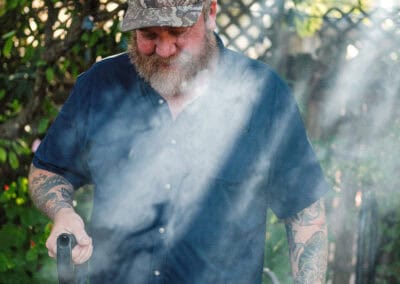
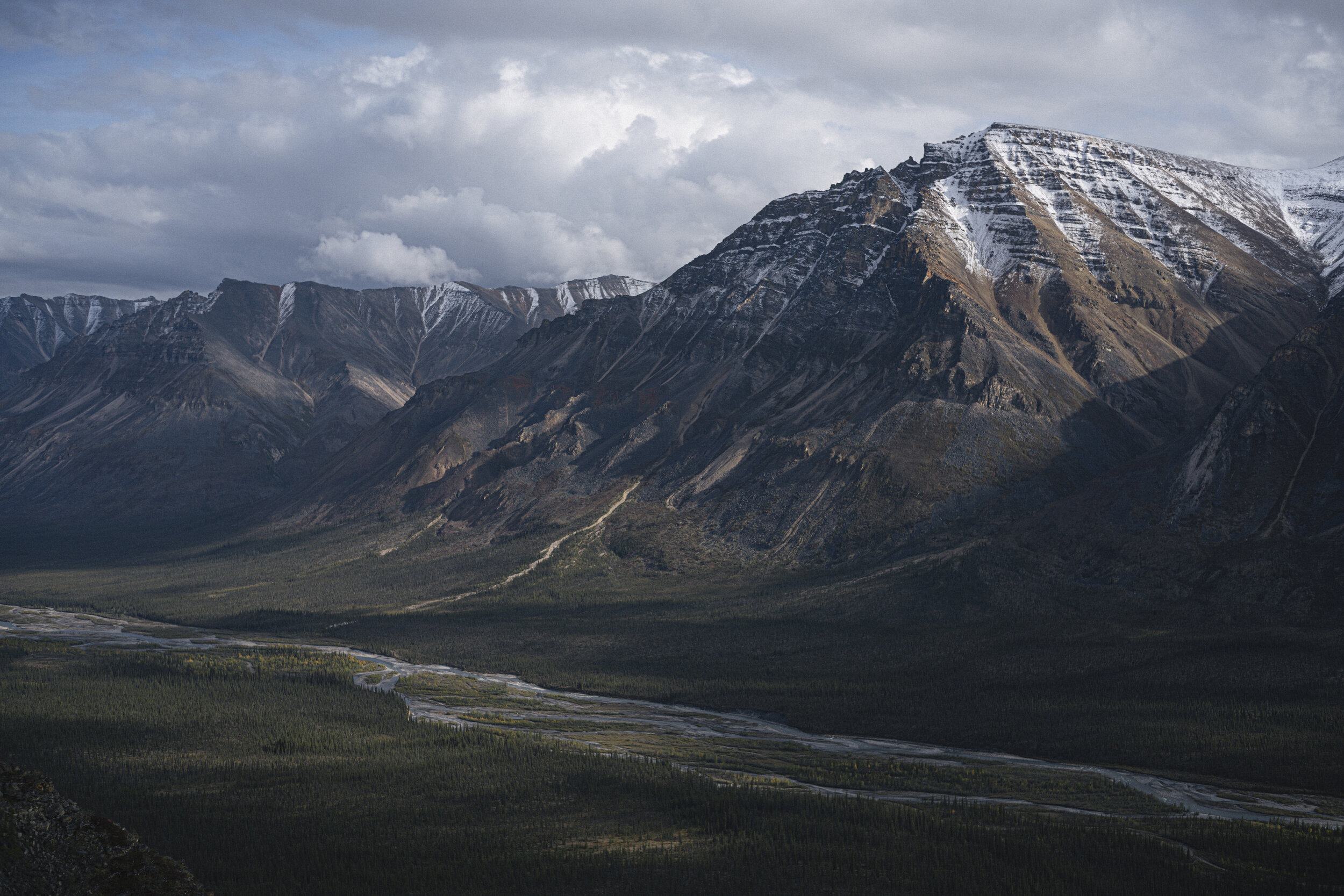
DAY 1: AUGUST 23, 2019
We wake at Palmer Lake early to saddle up, pack 17 horses and depart from base camp. There’s nervous energy in the air, filled with the anticipation of leaving civilization behind to spend two weeks in the middle of nowhere. Our simple, but intimidating pursuit is this: find both a mature Dall sheep ram and a mountain caribou bull.Our guide, Dane, leads the pack-string, with Jess and me riding behind. No lead ropes are necessary for the pack horses — they roam freely around us and keep up with the group. I ride a beautiful white half-draft that behaves perfectly for the novice rider that I am. It’s clear that this isn’t his first time. The river-flats turn into steep, rocky slopes, with the Mackenzie Mountains towering over us on either side. Jess comments, “What a quaint idea of wilderness we have in America.” She’s right. We spot a caribou cow and a calf near the bank of the Fritz River, whose cold flowing waters would eventually wind their way to our camp. The animals surprise me by moving toward us, clearly inquisitive. We keep riding so as not to bother them.
After arriving at the first camp, we set up our wall tent before riding back to the river-flats to await the Super Cub. The small plane would fly from the base camp we left earlier to drop grain for the horses and other supplies for us. Glassing from the riverbank through my binoculars, I spot a blonde grizzly bear walking parallel about 200 yards away. As I raise my binos to get a closer look at his face, he glances just once in my direction before ambling on. I don’t expect to forget the details of the bear’s face soon. His black, deep-set eyes and long snout seem proportionately small within an impressively broad face. We never feel threatened, but Dane immediately brings his rifle to hand, a habit learned over many seasons here in the NWT. In that moment, I quickly learn to follow suit.The plane’s arrival and delivery of a few days’ worth of food brings an end to our foray, and we return to camp for Fjell’s dinner of caribou sausage and canned corn heated over the open fire. She is not only the trail cook but also Dane’s wife, adding to the feeling that we’ve just stumbled into a family in the remote wild. A young horse wrangler named Myles also joins us in camp, tasked with rounding up the horses each morning and overseeing tack and other camp maintenance. The personalities were diverse and fascinating, and it’s already apparent that the trip will be filled with life lessons. Our dinner conversation returns to bears and their reputation for camp visits. As we tuck in for the night, each has a loaded gun within reach.
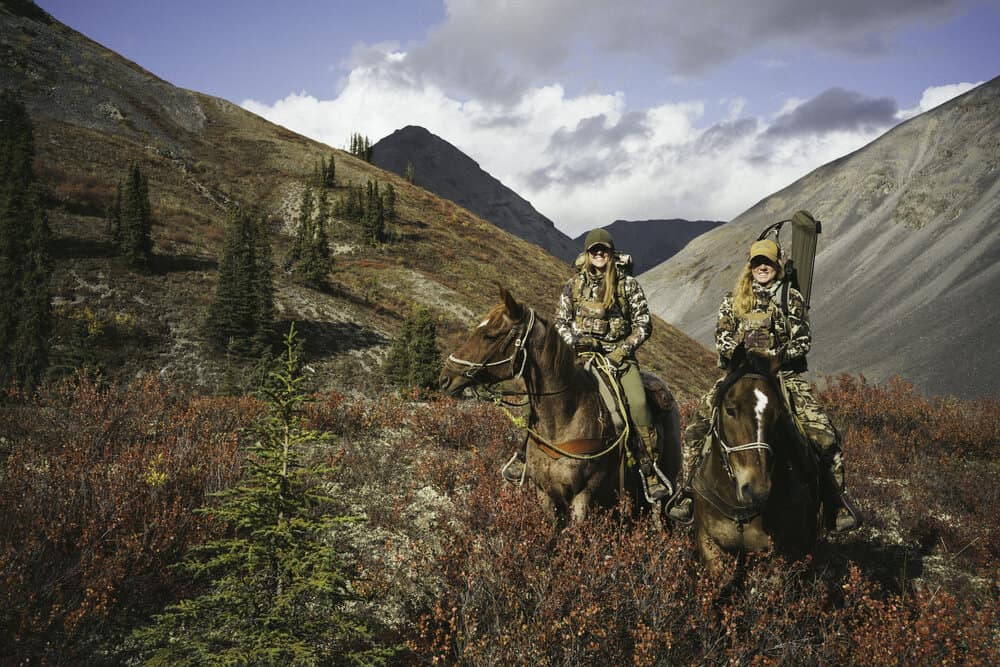
DAY 2: AUGUST 24, 2019
Breakfast is eggs, caribou hash and toast. I am shocked and unprepared for how decadent the food is. We start to make a plan, but mid-sentence Dane goes mute and grabs his binoculars, and the plans change entirely. Four Dall rams graze the mountainside behind us, and one of them looks to be big and old. We saddle up and strike out north of camp. We want to get as high as we can on horseback, tie up and then continue on foot. The chute we choose to ascend holds a small trickle of water and an impassable waterfall. Opting to sidehill, we climb an open-faced expanse of hard dirt and tumbling rock that never feels flatter than a 50-degree angle. Halfway there, it’s clear that this path isn’t safe, but it’s too late to turn back. Sliding shale, loose dirt, and boulders the size of cattle shift beneath our feet.
This landscape isn’t for the faint of heart. I hear a commotion behind me, the sliding of rock and a sharp inhale of air, then Bridget’s voice in a strained request.“Jess, I need some help.” She’s clinging to a nearly vertical edge and is all out of handholds. I turn around, grab her arm and hoist her up, and we continue on. Dane turns to our photographer, and we hear him say that not many hunters would attempt to scale this. It boosts my confidence just enough to press forward. We find a glassing niche that is slightly less steep than our surroundings, and hunker into the rock. The views from this angle remind me of biblical paintings. Giant sunbeams stream down on the jagged country. Above us, a couple of rams are bedded down. Neither is the one we seek, but watching them opens a window into another world.
We spend the day in the company of sheep, and time passes quickly. As we choose an alternate route down the mountain, the descent is technical but not impossible. Back at camp, legs tired, we gather around the fire, hot drinks in hand. A grizzly wanders into camp, ambling within 10 yards of the backs of those around the campfire. I’m the first to alert. “Bear … Bear … Bear … BEAR!” Dane swings a rifle comfortably to hand and the rest of us stand amidst a chorus of “Hey bear” and “Get out of here.” Dane doesn’t fire but stands ready. The bear decides we are more work than it’s worth and tucks tail back up the hill. In outfits like this, the rifle is the preferred bear deterrent. Bear spray becomes tricky to handle in the constant up and down of airplanes needed to access places like this, and honestly I think in these instances, the rifle made sense.
DAY 3: AUGUST 25, 2019
BRIDGET: What a hunt today, in perfect weather. Our feet are sore but happy. Homemade chili back in camp hit the spot, topped off with a s’more over the campfire. I haven’t showered in days, but I’m content and solely focused on finding an old ram tomorrow. Life is simple here!Today, we saw 16 rams, 1 pika, and 12 ptarmigan.
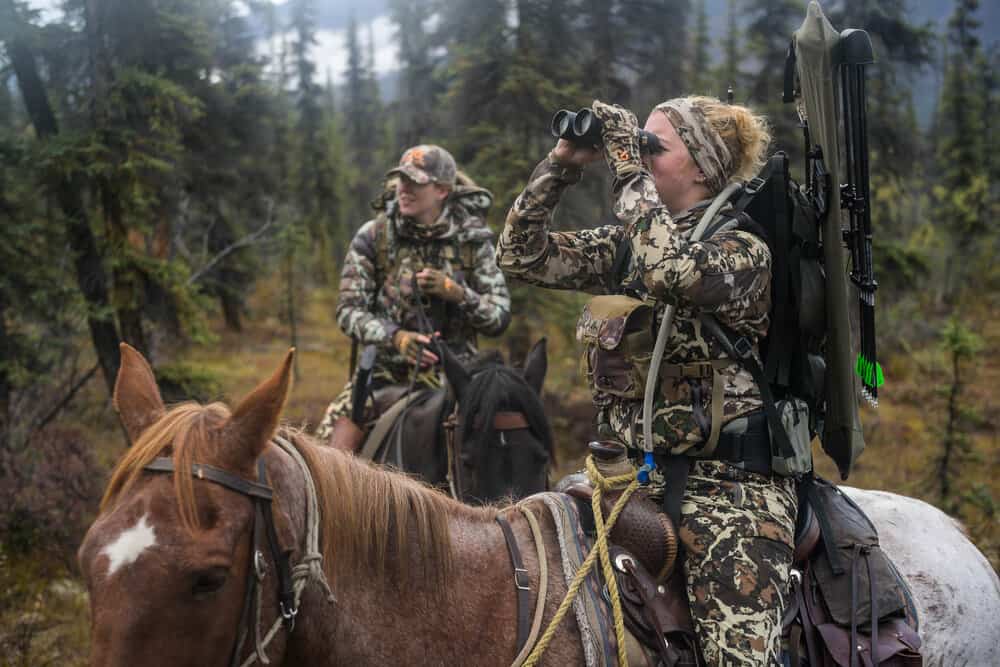
We ride to a canyon named Ledbetter. Dane smiles while claiming that “the lead flies better here.” A group of white dots high up a nearby rocky face catches my eye and we eagerly look closer. The crew glasses up five altogether, but Dane determines them all to be too young to pursue. NWT rules state that a legal ram is a three-quarter curl, with no age restriction, but “Harold rules” — those prescribed by our trusty outfitter — are to seek out the older, 10-plus-year-old rams. This is a rule that Jess and I both decided was more important. Harold manages this land and the wildlife on it. He controls the tags and hunts in a way that best sustains the resource. A 10-year-old ram has lived through 10 extreme winters and is nearing the end of his lifespan. The landscape makes you feel small. We step back into the saddle, ride deep into the most gorgeous canyon I’ve ever seen, and tie down the horses in an open spot where fall colors are exploding around us. It doesn’t take Dane long to spot more sheep farther downriver. We hoof it over the rocky embankments, staying out of sight until we get within 450 yards. High on the steep, craggy mountain face, we can make out a dozen sheep. Visible are four full-curl rams, but none older than eight years old. Dane wants to find an old ram. I trust him, and agree to wait.
DAY 4: AUGUST 26, 2019
JESS: We headed back to Ledbetter today. The ride was longer this time as we pressed farther into the drainage. 3 ½ hours of riding leaves legs stiff and hips sore. Almost out of trees, we tie up the horses on some sturdy-looking willows. I am riding Tarzan, a 15-year-old red roan, half-draft gelding. He’s put his time in in this country. Surefooted and a little dense in the head, it’s hard not to love him.
After many miles, long days, lots of sheep but no “Harold legal” ram, our crew’s attitude turns from naive elation to dogged determination. We’re no less optimistic, but a little more realistic. Every peak is followed by another. Grassy moss turns to steep shale that takes both legs and arms to climb. We find a fresh sheep bed at a windy summit and stare across the valley at a group of ewes and lambs feeding in a carpet of green. The ridgeline we’re on has me thinking, “this is an epic photograph.” My mind wanders, before snapping back to the present as Dane suddenly crouches. “Sheep,” he whispers, giving a hand signal indicating that it’s 100 yards from us. Adrenaline slams in, directly followed by tunnel vision and utter focus. Bridget gets her rifle out and we drop our packs, inching slowly forward.
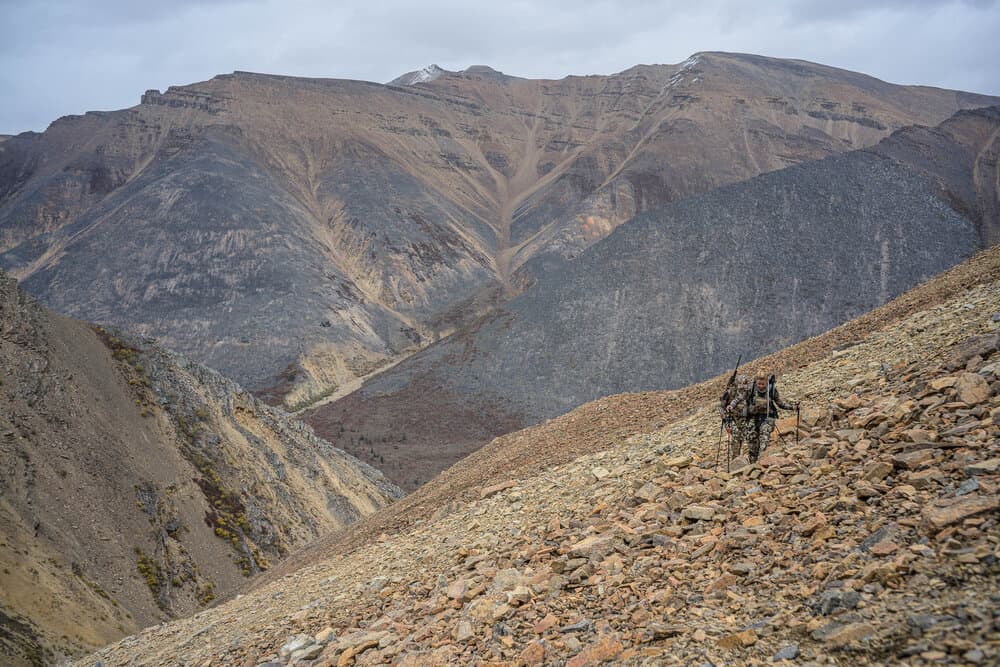
An agonizing few minutes later, we peek over the ridgeline. Five ewes and a small ram stand at attention, drilling holes into us with their eyes. They’re not the sheep we are looking for, but what an experience to be so close. They cross 2,000 yards of treacherous footing in under 30 seconds. I am left in silent appreciation of their prowess. We sit back and take stock. No big rams today, and we likely won’t return to this drainage. A grizzly at the valley floor catches our eye. She is running, covering ground in huge loping strides laced with purpose. We watch from miles above as she moves toward the horses. Our hike down is slow. Each footstep is precarious. The ever-shifting shale leaves our calves burning from exertion. Watching closely, we keep an eye on the grizz below as she moves in our direction. We don’t see her again until our ride out, sitting in a blueberry patch gorging herself. How joyful to be a bear in this country.
I found a small trilobite today, and I feel like the mountain gave me a gift. I tuck it into my binocular harness and end the day with a sense of gratitude.
DAY 5: AUGUST 27, 2019
BRIDGET: We rode far down a new, giant canyon and spotted a nice ram this morning. From there, the day turned into a complete misadventure. Tying up the horses and setting off on foot has me taking stock of the aches and pains in my body. I didn’t expect this to be easy. But do I have another week of this terrain left in my legs? The numbness I feel in my knee makes me question myself.
We have a great setup to move in on the ram, bedded on some green slopes, but something above spooks him and he takes off down the mountain and up the other side of the canyon. As it’s early in the day, we decide to change course and make a play up the opposite side. That’s when I realize that what looked like a fairly smooth slope is actually a bed of energy-sapping loose shale.
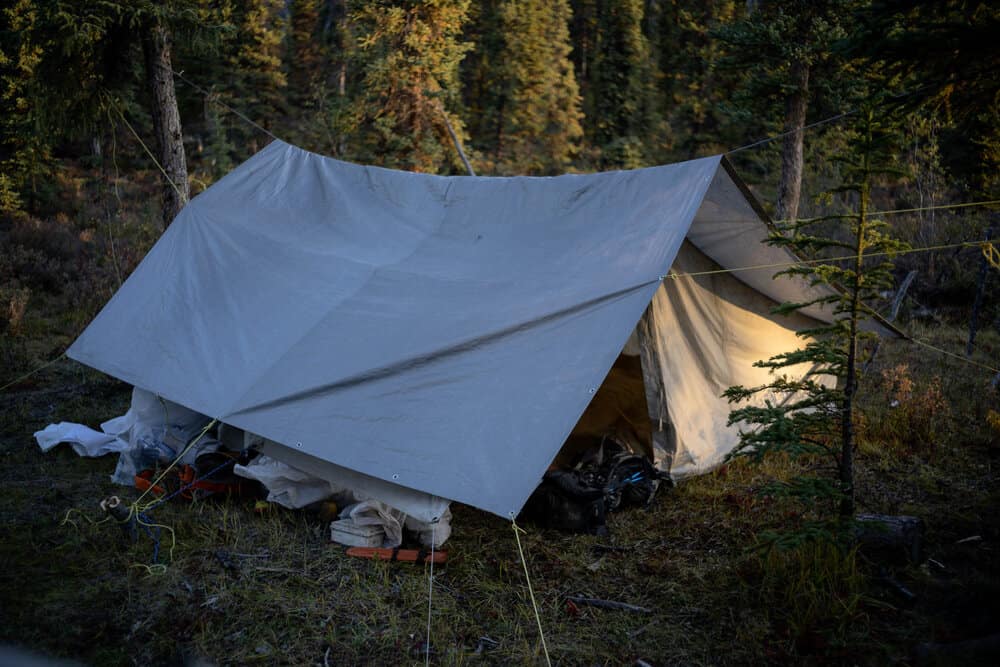
The rocks move like quicksand as we wedge ourselves under a sharp overhang. It’s become apparent there’s no safe way to continue climbing, and we need to back off. On the way down, we turn and look skyward, only to see the ram again — a perfect full-curl sheep with heavy mass (eight or nine years old), looking down at us from the highest ridge. A final rub of salt in the wound for out-hiking us.Shortly after that, Jess puts her first stalk on a caribou bull with her bow. He’s a gorgeous caribou, standing broadside at 25 yards with a flowing, majestic white beard. Jessi watches but doesn’t raise her bow, determining (with Dane’s assistance) that this isn’t a mature animal and she isn’t ready to end her hunt so early. As a bowhunter, making these decisions is never easy — it requires an immense amount of control, confidence and respect for the animal. It’s incredible to watch this scene play out from the back of my horse, not even 100 yards away.We take the long and gnarly ride back to camp, returning just after 10 p.m. We are more than ready for a hot meal, and it’s time to reset for tomorrow.
DAY 6: AUGUST 28, 2019
JESS: I am aching and my joints are making clicking complaints with every flex and extension. Feeling the first touch of frustration at not finding an older sheep. Remind myself this is a privileged feeling and adjust my mood. Today started drained but determined.
JESS: “Today, we will find a 12-year-old ram,” I say in an attempt to lighten the mood. We make the decision to ride back into yesterday’s large valley. Maybe today I’ll shoot a caribou.
BRIDGET: We do find three caribou bulls this morning, and Jess puts a stalk on them, getting as close as 40 yards from their bedded position. One bull sports a blood-red antler, dripping in velvet. The young bull that she moved in on yesterday is also in the group, along with a modestly large caribou that she’s interested in getting a closer look at. From a sunny spot not far away, Dane and I crouch and watch her stalk in. My vantage point allows me to see just the tips of three sets of antlers and the back of Jess’s head as she slowly, surgically cuts the distance. At some point, the bulls stand up in alarm. Whether it was a sound, smell or sight, we don’t know. They run a short way off before looking back to survey the scene. Caribou have a way of floating over the mossy landscape that’s dissimilar to any other animal I’ve seen in the wild. Watching their white tails disappear over a low ridgeline, we regroup to digest this close encounter and pull our minds back to the sheep hunt.
JESS: Dane spots four rams on the opposite side of the valley. They’re just tiny white dots at the skyline, seemingly miles away. It is 2:35 in the afternoon. He turns, a huge grin onhis face. “He has fists right at his cheeks!” Dane exclaims. Meaning: it’s a big ram. Bridget and I share a look. It’s now much later in the afternoon, and we are both feeling beat up. If we choose to go after this sheep, it will most likely mean we’ll be out all night. But, we’ve never seen Dane this excited. We buck up and go. The hike in is straight up, followed by a long slog of a steep sidehill that alternates between loose shale and large, unstable boulders. One misstep feels like it would be our last. I feel my energy waning, and I can tell Bridget feels the same, but we talk each other up the mountain.
BRIDGET: After six hard days of hunting and horseback riding, my knees are feeling the work, and I try my best to ignore the pain. The mental game is creeping in on me and I picture what it would feel like to get to the top of this mountain and find no rams waiting for us. All I can do is continue picking my way uphill.
JESS: We get into the drainage and stop to plan. “Oh shit!” A frantic whisper escapes Bridget. Six rams are above us, 300 yards uphill. Everyone freezes; seconds pass. Then, in slow-motion, the following sequence unfolds. I unbuckle Bridget’s rifle from her pack, handing it to her. Dane pulls his spotter up and ages the ram. He motions for Bridget to follow him a few yards closer. The rams aren’t overly worried about us. Silent and out of earshot, I watch Bridget set up.
BRIDGET: I unfold my bipod on a semi-flat section of rock, putting the lead ram in my sights. He’s stacked in front of two other sheep, and I have no shot. Dane keeps calm and assures me that the sheep will take a step forward. He does.
JESS: I can feel Bridget’s energy from across the creek. Watching through my spotting scope, I pick out the largest ram. CRACK. The first shot fires, and the ram in my scope doesn’t move. A few seconds pass, and another sheep enters the frame. I glassed the wrong ram, and now it’s wildly apparent what a big Dall sheep looks like. It’s the ram that Bridget has in her sights. He’s broomed on both sides and holds about twice the mass of horn over anything around him. He looks healthy. No sign of having been hit. CRACK! I startle a little, watching the ram slow and begin to feel his wound. A few seconds more, and the ram stumbles. His fellow travelers either don’t notice, or they’re not bothered by any of the commotion. One final CRACK! The ram rears over backward and lies still.
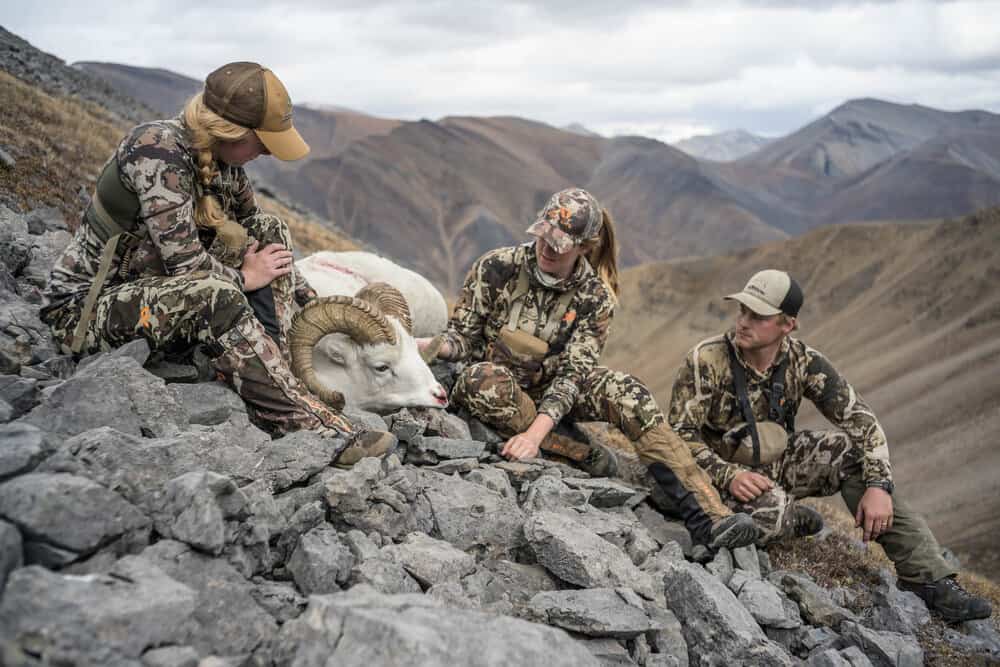
BRIDGET: I’ll have to go back and replay my memory to explain these moments fully. I know that my first shot sailed just over the ram’s back, because I saw the rocks explode above him. Did I range him wrong? Did the steep angle impact the shot? Was my scope level? Was it nerves? But this didn’t spook him, and I’m able to quickly re-rack as he takes a few steps forward. My second bullet travels through his shoulder and lungs. I place another one a bit lower, which ultimately puts him down. What feels like an hour likely passes by in just moments. The finality hits me as I see the ram — my ram — lying still on the mountainside way above.
JESS: Total silence. Only a faint wind rustles our coats. Bridget kept calm in a situation that would have caused most folks to panic. She focused on making sure the sheep did not suffer long, and while hunting doesn’t always go as planned, she made an ethical and quick kill. I am unsure of what emotion I feel. Joy, exhaustion, pride for Bridget’s cool-headedness, and a deep melancholic respect for an animal that hacks out a nearly impossible life on top of the world.
BRIDGET: I look at Dane to my left, who has a huge smile on his face. I turn to look back at Jess, crouched down 10 yards behind us. Her face shows tears of relief, excitement and pride. I share all of these emotions at once, but ultimately what I feel is joy. Our hard work in preparing for this hunt culminated in a good kill. After gathering our gear, we pick our way up the steep slope to the ram and absorb the moment. Dane is quick to count out the rings on this old sheep, and we determine that it is, in fact, a 12-year-old ram. Just like Jess foreshadowed that we would find today.
JESS: Butchering and filling our packs takes hours, and we don’t start our descent until after 10 p.m. By the time we’re halfway down the mountain, it’s 1:30 in the morning and dark. This is the first darkness I’ve been awake for in the NWT.
BRIDGET: The last light has long left the sky by the time our feet finally step onto the mossy lichen of the flat valley floor where we tied the horses. Their glowing eyes reflect in our headlamps as we approach, and the relief at being off the mountain gives us a new wave of energy. We lead the horses closer to the river and find a flat spot where we can comfortably lie down and attempt to sleep. We have no tarp or protection from the elements, so there’s little choice but to make do. Putting on every layer in our packs, we lie down to rest for a few hours in the drizzling rain. I use my pack with the ram’s head and cape as a pillow. In hindsight, this will seem a laughable decision as I consider how deep in grizzly country we were. We tie the horses in a circle around us so we’ll have a natural alarm system if a bear decides to make a nighttime visit. This gives me some comfort.
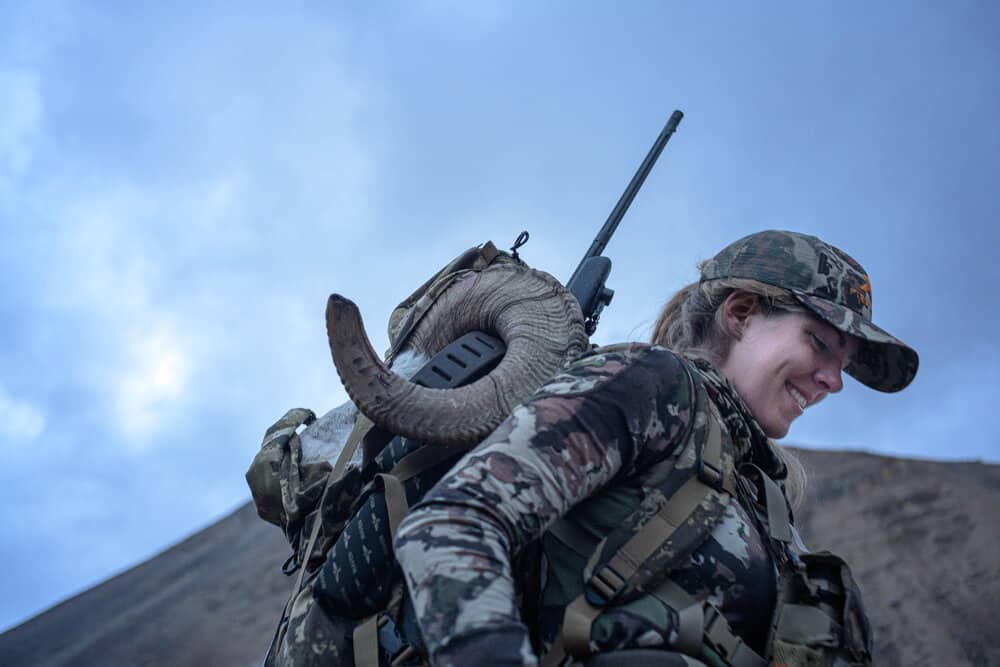
JESS: Bridget and I shivered most of the night, whether from adrenaline, exhaustion, cold or a combination of all three, I’m not sure. Today, we went on a Dall sheep hunt and we packed out heavy. I say a silent thank you to these mountains and this ram. Saw three Caribou bulls. Making bow range to all three feels like success in my book. Not an easy stalk. Saw six Rams; made it rifle range to all 6, one was a 12-year-old. Packed out a Dall sheep. What a privilege to be able to experience life here.
DAY 7: AUGUST 29, 2019
BRIDGET: Morning light shows around 5:30 a.m. Cold to the core, we start our day doing jumping jacks and jogging on the spot to get our blood pumping. It tests my balance to mount a horse while wearing four layers of clothing, carrying the weight of a sheep skull, horns, cape, and meat. We struggle through a three-hour horseback ride back to camp, with heavy packs, sore muscles and a curious bear at the mouth of the canyon. Our trail cook, Fjell, and horse wrangler, Myles, await our return at camp after we failed to return the evening before. Eagerly, we share the highlights of our success story with them before we turn in and sleep a full eight hours in the wall tent. Upon waking up, we celebrate with fresh sheep ribs salted and cooked over an open fire. It’s easily one of the best meals of my life.Shortly after, the Super Cub flies in to pick up the rest of the meat, cape and skull to bring it back to base camp for freezing and storage. We will continue on our adventure. Now to find some caribou.
DAY 8: AUGUST 30, 2019
JESS: Today we’re trailing to Double Header, a camp named for the two 40-inch Dall rams that were taken there in a single season. We leave before the pack string so we can hunt along the trail. Caribou is now the priority. I keep up a constant stream of questions on caribou behavior directed at Dane. What I discovered is that caribou are mostly unpredictable, a trait that probably accounts for the reason that they’re still around today. We encounter two wolf pups playing on a gravel bar. Both Bridget and I have tags in our pocket for wolves, yet neither of us know our exact feelings on hunting one. Being unsure is a solid enough reason for us to pass on shooting. Any wolf here is fair game legally, but it is hard to wrap my head or my heart around this. Perhaps one day we’ll both hunt a wolf and take a shot, but it’s not today. We post up on a glassing knob behind camp in the evening, eyes peeling the landscape, looking for the heavy antler of a caribou bull.
Tonight, I curl up in my sleeping bag and take stock. Plainly, I ache. Sheep country and hours in the saddle are wearing me thin. Emotions are all over the map. I also feel the most alive I have ever felt.
DAY 9: AUGUST 31, 2019
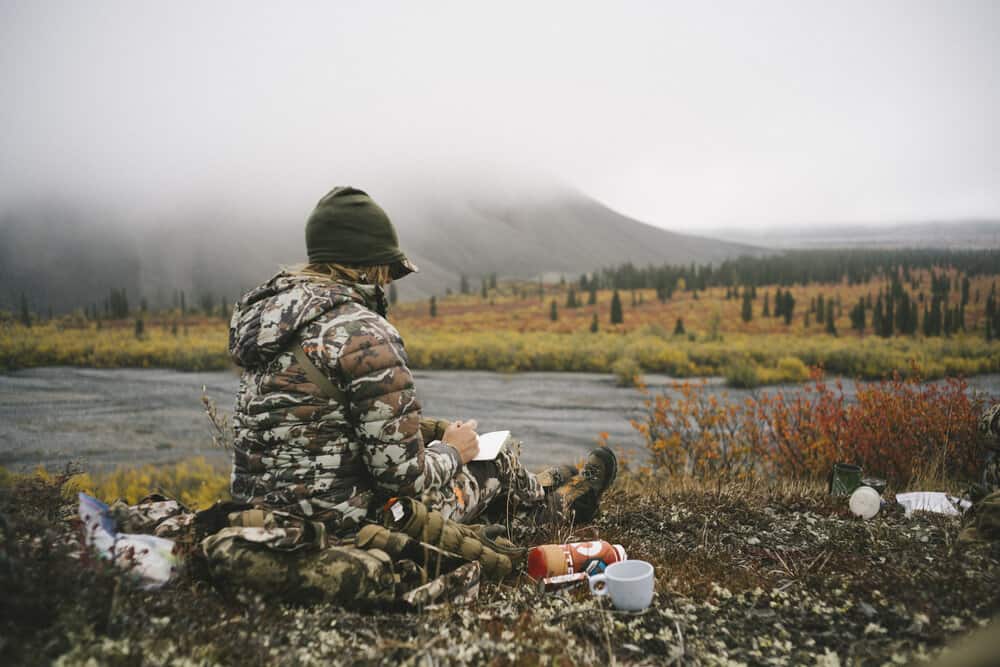
JESS: Myles, the wrangler, sings to the horses in the morning as they trail back into camp for some scratches and oats. I will miss this when we leave. We have seen a bear every day we have been here. I spend the day finding glassing positions that are strategically placed in blueberry patches and my fingers are stained purple by the end of the day.
Caribou hunting is the complete opposite of sheep hunting. It’s a waiting game. In the morning, we climb the glassing knob, and settle in to spend the day in good company waiting for ‘bou (this has become a camp-favorite slang for caribou). It is foggy, and the low-hanging mist covers the gravel bar and obscures our view. It is an eerily quiet dawn, and no one talks or moves much for the first few hours. Five caribou cows wander into our limited viewshed. They look to be ambling slowly south, following the winding Fritz River. Seeing any caribou at this point feels lucky, and we relish the sight of them. It seems that we may have missed the heavier part of the migration.
Dane trades banter with Myles. He is eager to be a guide and is a truly good individual, if a little innocent. We talk about faith and our various different beliefs. I sit back and enjoy the feeling of being surrounded by a diverse set of people who deeply love this place. Some of us are fresh and new to this feeling; for others, it’s well-worn and familiar. This evening, we say goodbye to another hunter as he flies back to base camp. Logistics on getting hunters and gear back with a Super Cub require some juggling, and it’s unclear if we will be flying out soon or spending more days hunting. Dane and Fjell ride for the airstrip, while the rest of us sit around the fire trading stories. A loud rifle report echoes off the mountains, sending us running for the glassing knob. A few seconds behind binoculars and the scene unfolds. Dane and Fjell are standing in the middle of the gravel bar next to a pile of food and supplies. A dark-bodied, silver-tipped grizzly circles them. Dane has his gun up, having just fired a warning shot. The bear seems unconcerned, striding in ever-tightening circles toward the gear pile on the ground. This tense confrontation lasts nearly a half-hour, but finally the bear loses interest and wanders off. Dinner is accompanied by stories of bear attacks and a healthy reminder to carry a loaded rifle when on trips outside of camp.
DAY 10: SEPTEMBER 1, 2019
BRIDGET: We rode the horses up to a new glassing knob further from Double Header today, and Fjell joined us this time. It’s another foggy morning, but it’s lifting as I write this. Jess is intent on shooting a caribou with her bow, but she will not consider the hunt a failure if she goes home empty-handed. We discussed what “success” means many weeks before embarking on this hunt, and agreed that it doesn’t always mean filling the tag. I respect her steadfast resolve to come to the NWT with only a bow, the instrument she is most confident using.
In the offseason — outside of the 250 days a year when he’s guiding — Dane works the heavy-duty haulers in the oilfields of Alberta. He is one of the hardest workers I’ve ever met. His wife, Fjell, works equally hard managing our trail camp and keeping the whole operation running smoothly. She offers a refreshing perspective on life up north and the history of her family’s outfitting business. There are so many differing personalities and backgrounds on this hunt. Some of us were ranch kids, and some of us just learned how to properly cinch a saddle. Some of us have dreamed of sheep country since birth, and some of us are new to the wild adventure of it all.
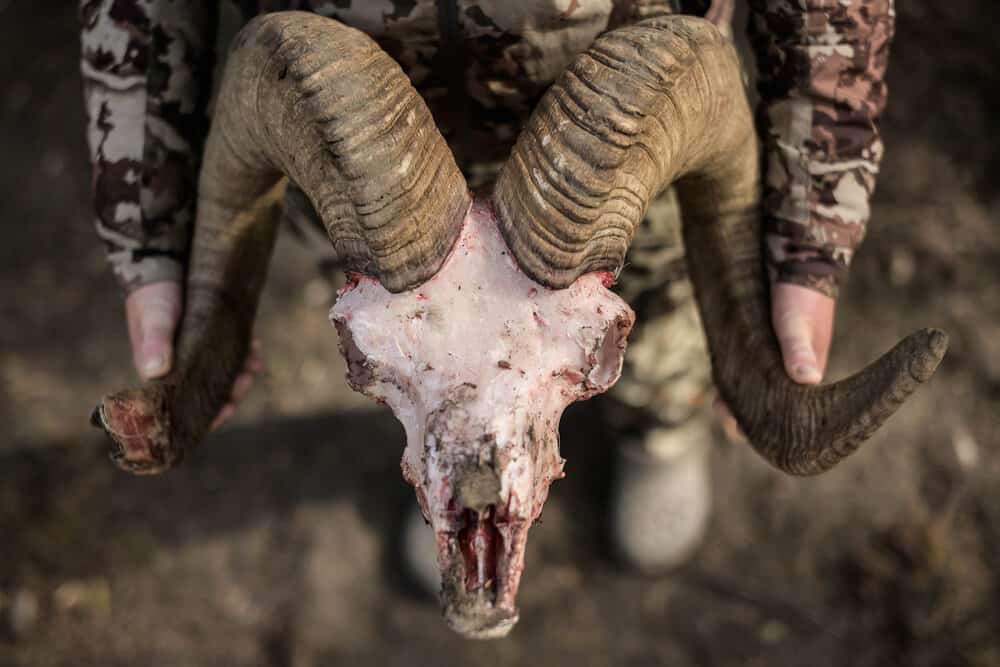
DAY 11: SEPTEMBER 2, 2019
JESS: Hunters don’t usually trail out to Willow Camp. It is explained to us that because of a 17-horse pack string, a 10-hour ride, and the ruggedness of the country, the crew finds it easier to send hunters back to camp in the Super Cub. I am excited to be included in this task of getting to another camp. Scout, the young paint I am riding is newer to the pack string, and stands at the bottom of the herd’s pecking order. We ride in the back at a quiet pace, enjoying the scenery. Weather has been hit or miss. Rainstorms move through, dumping their water on us for twenty minutes and then pass on. Part of riding with this pack string means we never stop; a constant trail of moving horses is about the only way to get everyone to fall in line. Dane leads, and the rest of us pull up the rear, herding the horses through the tundra valleys. The colors turn from a severe, rocky gray to a watercolor of fall splendor. Steep faces painted in reds, yellows and pale greens surround us. We pass a bull caribou and a calf heading in the opposite direction. I consider grabbing my bow and hopping off, but I now know the reality of keeping this pack string going. I watch the last bull I will likely see trail into our dust. We have been hearing stories of this ride from the crew. With sections named Racehorse Hill, The Hole, and Deadman’s Gulch, we’re left guessing at what to expect. The horses ahead disappear into Deadman’s Gulch, and suddenly I understand how it got its name. It’s a narrow drainage with steep rock walls, the trail barely wide enough for a single horse and pack. It’s an eerie feeling being stuck between a hard place and a vulnerable one.
Willow Camp is yet another stunning landscape, its fall colors on full display. Dane spots a bull moose in the distance and I go to bed on our last night out feeling hopeful for an 11th hour hunt. I am thankful for Bridget and her consistent affirmations of caribou.
DAY 12: SEPTEMBER 3, 2019
BRIDGET: At this point, it seems to be an unspoken truth that the caribou have moved on. We all know it, but we keep our heads up and keep glassing.
JESS: We sit high on a slope, overlooking the valley and Willow Camp. We talk about wolves, grizzlies, and the differences between Canadian and American wildlife management. Individual flights back to camp are as follows: our photographer Rick goes first, then Bridget, and finally it’s my turn. I spend my last few hours sitting in the sun with my back against the small cabin wall, talking with Dane.
BRIDGET: The Super Cub is on its way to pick us up one by one with our gear, then it’s a 45-minute flight back to base camp. I think it’s been two weeks since the last time we even saw a shower. Clean river water and wet wipes go a long way, but I’ve stopped even attempting to get the dirt out from under my nails. And with the landscape and simple way of life out here, I’m not mad about it.The flight back to camp offers some time to reflect. Landing on the airstrip at Palmer Lake feels like an entrance back to civilization, even though there will still be at least five flights before my feet return to Idaho soil. These past days in the wild corners of the Northwest Territories have been life-changing. I finally understand why people who have experienced it will spend their lives trying to return to sheep country.
JESS : It’s been 15 days since we began this journey, and I can’t remeMber what jeans and a tshirt feels like. I don’t care. Life is simple here, ad he simplicity prioritizes what is important. The flight out is spectacular. We cross over Country I have gotten to know on foot and horseback. I can point out familiar summits as the river flats paint a breathtaking scene below. I keep looKing up at the MOUNTAINS trying to figure out how to say goodbye. I decide to say until next time, this place is in my bones and has left an imprint of wild tot the marrow. I will be coming back.
Related Stories

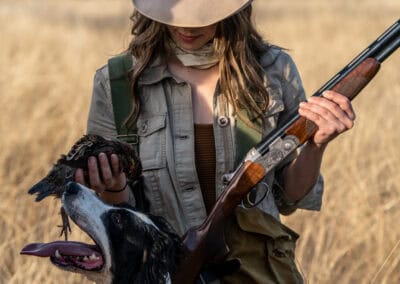

Latest Stories


